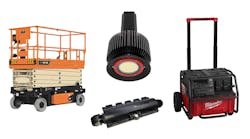Today, LED lighting products offering more than 100 lumens per watt (LPW) are not uncommon. Providing efficient lighting compared to traditional light sources, LEDs are showing up in all shapes and sizes — with some fitting into traditional sockets and others permanently integrated into the luminaire. Each of these formats addresses certain applications, but the real challenge is how to meet the needs of the larger commercial markets by coupling high performance with end-user convenience to maximize light output, life, and ease of field replacement.
Why should we care about field replacement?
Many early LED luminaires were designed with the LEDs permanently affixed to the fixture. This design provided great thermal management, which maximized light output and product life. But like all electronic products, they still have infant mortality rates and are susceptible to damage after installation. In addition, without an easy replacement option, upgrading to increasingly more efficient LEDs is impractical. To gain the efficiency of LED technology across the broad market, building occupants will need to have confidence that they can replace their “lamps” in the future.
The Department of Energy’s Designer Roundtable on the subject cited replacement parts and lack of modularity as major drawbacks to LED adoption. NEMA recognized this in its 2009 white paper, “LSD 44 Solid-State Lighting — The Need for a New Generation of Sockets & Interconnects.” According to the paper, “Currently, in many LED fixtures, the LEDs are considered ‘permanent’ and cannot readily be replaced in the field by end-users or field service personnel. Some LED fixtures treat the LEDs as parts of sub-modules that could be replaced, but are not necessarily constructed in a manner for a ‘simple’ swap without major disassembly of the fixture… . Growing experience with LEDs shows that failures do occur… .”
Why is thermal management important if LEDs use so little energy?
It does seem contradictory that a high-efficiency product needs its heat output well managed. Actually, LED products produce much less heat than traditional light sources. The difference is the heat produced in an LED product is highly concentrated at the LED itself, thus creating a very small area of high temperature. The LEDs have a critical temperature at which their life will be greatly affected. Good luminaire design requires a product that reliably stays below this temperature while maximizing light output. Traditional lamps with Edison bases, or CFL pin-bases, etc., were not designed to conduct heat away from an LED inside a lamp. Consequently, LED light sources that use these traditional interfaces have to sacrifice either lamp life or lumen output. NEMA recognized this in the same white paper (NEMA, LSD 44-2009): “The use of existing sockets compromises the capability of solid-state lighting. Existing sockets are sub-optimal mechanical and optical configurations. Existing sockets do not provide an adequate thermal path.”
LED product development for general illumination initially followed two different paths: 1) using integrated luminaires for great performance, and 2) using traditional lamp bases for easy replacement. As previously mentioned, the first provides the very best performance, but makes field replacement more challenging. The second option addresses the residential replacement market well, but is limited to products that cannot properly manage heat, resulting in decreased product life, lumen output, or both.
As people began to realize the importance of thermal management and serviceability in the commercial markets, replaceable modules and retrofit kits with good thermal conduction paths were introduced. Many of these proprietary systems perform well. However, given the fact that each has a unique format from a different manufacturer, the fear of obsolescence, lead-time for replacements, and costs deter broad acceptance. Fortunately, the industry recognized this and set out to make changes.
Creation of Zhaga
In March of 2010, a group of lighting-related companies from around the world first met to form the Zhaga Consortium, an industry-wide cooperation aimed at the development of standard specifications for the interfaces of LED light engines. The goal of this group is to enable interchangeability between products made by different manufacturers.
As the Zhaga website states: “Interchangeability is achieved by defining interfaces for a variety of application-specific light engines. Zhaga standards will cover the physical dimensions as well as the photometric, electrical, and thermal behavior of LED light engines.” The site goes on to explain that the organization was established for the benefit of the consumers and professional buyers of light engines and luminaires, in the expectation that standardization will prevent market fragmentation into incompatible products. “Zhaga standards will increase the confidence to specify and purchase LED products that will be easily replaceable and commercially available, while continuously enjoying the performance upgrades that LED technology enables. In addition, this will foster innovation and competition in the application of LED lighting in general.”
Zhaga companies have already made great progress in several applications, including down lighting, spot lighting, street lighting, and ambient lighting (such as linear fluorescents). For each of these, Zhaga is defining four interfaces between the light engine and the luminaire: mechanical, electrical, thermal, and optical. The Zhaga specifications only define the outside of LED light engines. Zhaga treats a light engine as a “black box,” with defined interfaces that do not depend on the technology used inside the light engine. This enables maximum innovation within products while assuring a mating interface on which users can rely.
Approved Zhaga Specifications
Since the formation of this organization, Zhaga members have demonstrated a sense of urgency. A few specifications are already approved, and member companies are developing products to meet these requirements now. These standards are written so that specifiers can be assured these products will be compatible with each other as well as with replacement products developed in the future. Following is a summary of the significant activity that has taken place already.
The first specification was approved in February 2011 for a socketable light engine with integrated control gear (Photo 1) for use mainly in downlights. Several companies provided prototypes and input to the development of the light engine and mating holder (Photo 2). The design creates a large thermal interface between the light engine and heat sink to enable the long-life and performance expected of LEDs, with the replacement as easy as a quick twist.
Continue to Page 2
A second specification was approved at the June 2011 meeting. This is the specification for the interfaces of an LED spotlight with the control gear located in a separate housing. As can be seen in Photo 3, the physical size and mounting of the modules are consistent, so that replacement in the field is simplified.
At the September 2011 meeting, the Zhaga members approved a third Zhaga specification. This specification describes the interface of a socketable spot light. The control gear of this spotlight engine is again located in a separate housing. Where the previously approved spot light engine was meant for direct screw mounting, this new specification allows for simple twist replacement of the module into the holder (click here to see Fig. 1).
The group is currently working on two new projects:
- A light engine with a non-socketed linear module with separate control gear for indoor applications that will be merged from several proposals in the coming weeks. One indoor luminaire may contain several of these rectangular modules and one control gear.
- A non-socketed, street lighting engine with separate control gear.
In addition to the interface specification of light engines, the Zhaga Consortium is also developing supporting specifications that will be relevant for multiple light engine interfaces, such as the physical size and screw locations of LED control gear.
Zhaga established a task force earlier in 2011 to study how the dimming of LED light engines can be specified such that the light engines become interchangeable in their dimming behavior. The task force’s first priority is phase cut dimming. Zhaga does not plan to create a Zhaga specification for dimming, but will cooperate with NEMA, who is taking the lead to establish a dimming interface standard that is suitable for LED light engines.
Expect to see the Zhaga logo (Fig. 2) on numerous products starting this year to communicate compliance to Zhaga requirements. To prevent abuse and establish confidence in the user community, the Zhaga logo cannot be used on a product, nor can a product claim Zhaga compliance until the manufacturer agrees to the terms of the Zhaga Trademark Logo License Agreement — and has had the product tested by an approved third-party test house for complete compliance with the Zhaga standard.
The goal of the Zhaga Consortium is to create peace of mind in the specification and end-user communities that reliable LED products can be selected and will be available from many manufacturers well into the future. Although other formats will continue to find a home in the lighting world, the need for standardized and high-performing LEDs is needed — 2012 is the year this will start to become a reality.
Swedberg is the business unit manager for engineered solutions at Ideal Industries, Inc., Sycamore, Ill. He can be reached at: [email protected].
SIDEBAR: LED Lingo
Because many of the terms used in the LED lighting world are not the same as those used to define traditional light sources, a quick vocabulary lesson is in order.
Control gear (commonly known as driver): Acting somewhat like a ballast in fluorescent lighting, the control gear is made up of electronics that convert input power into the necessary power to drive the LEDs — often converting line voltage to lower voltage DC with either constant current or voltage output. The control gear also protects LEDs from spikes and fluctuations from the input power.
Heat sink: The part of the luminaire that conducts the heat away from the LED.
Light engine (LLE): The LED module and control gear taken as a whole. This might be an integrated assembly comprised of LED module and control gear in the same housing, somewhat analogous to a self-ballasted CFL lamp. It could also be a module and control gear in different locations within the luminaire connected by a cable, similar to linear fluorescent lamps with ballasts.
LED luminaire: A complete lighting fixture containing the LED module and control gear along with the mechanical attachment to the building structure, J-box for electrical connection to the building, heat sink, and reflector or other optics.
LED module (also known as an array): An assembly of LED dies on a printed circuit board, with means to connect electrically, mechanically, and thermally to the LED luminaire.







